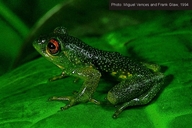|
Description
A small-sized treefrog, males and females 20-23 mm. The back of the males is greenish, greyish or yellowish, females are light brown, sometimes with two large yellow dorsilateral marks. Flanks sometimes with black and white markings. Venter uniformly whitish. Skin on the back granular in males, with a lighter colouration of the granules; smooth to slightly granular in females. Nostrils slightly nearer to tip of snout than to eye. Tympanum indistinct, tympanum/eye ratio is 1/3. Tibiotarsal articulation can reach the tip of the snout. The only known Boophis without vomerine teeth. Hands with a trace of webbing; webbing of the foot 1(0.5), 2i/e(1), 3i/e(1), 4i/e(1), 5(0.5). Males with nuptial pads and a single subgular, barely distensible vocal sac.
Similar species: Could perhaps be mistaken with species of the B. rappiodes-group, and with juveniles of other Boophis.
Distribution and Habitat
Country distribution from AmphibiaWeb's database: Madagascar
Ambatovory, Andasibe, Ifanadiana, Ranomafana, Ranomafanakely, Tolagnaro. Strong genetic differentiation among populations. Observed at elevations from sea level to 1,100m asl in ponds and swamps of secondary and degraded forest, and in agricultural areas (Cadle and Vences 2008).
Life History, Abundance, Activity, and Special Behaviors
Habits: Males call from shrubs near pools in, or near, forest, or swim in the water and dive when disturbed. Couples in amplexus were also observed swimming and diving.
Call: Typically a single short and loud note repeated after irregular intervals, resembling the yelping of a young dog. In highly motivated choruses, trill notes can be heard as well.
Eggs and tadpoles: We found very characteristic tadpoles at Ankeniheny and Marojezy which developed into juveniles with colouration patterns strongly reminding the pauliani females described above. The tadpoles were captured in pools near slow moving brooks in primary forest. Two colour variants were found in syntopy which are similar in morphology and tentatively we regard both as the same species. One variant is uniformly greyish, the other is coloured aposematically: black with one distinct transversal yellow band on the back and one yellow spot on the snout. Characteristically the caudal musculature at the base of the tail is thickened and enlarged, reaching into the caudal fin. At midlength of the tail, the caudal musculature represents about 2/7 of the total tail height. The tip of the tail is sharply pointed. The caudal fin is transparent. Tooth formula is 1/4+4//1+1/2. Total length in stage 27 is 27-29 mm, body length 10-11 mm. Two metamorphosing young measured 13.5 and 15 mm. They were grey with two large whitish dorsilateral patches. Fore- and hindlegs with dark transversal bands.
Trends and Threats
It occurs in the Réserve Spéciale de Kalambatritra, Parc National de Ranomafana, and in protected areas near Andasibe (Cadle and Vences 2008). Possible reasons for amphibian decline General habitat alteration and loss
Habitat modification from deforestation, or logging related activities
Intensified agriculture or grazing
Habitat fragmentation
Comments
Taken with permission from Glaw and Vences (2007).
References
Cadle, J. and Vences, M. (2008). Boophis pauliani. In: IUCN 2008. 2008 IUCN Red List of Threatened Species. www.iucnredlist.org. Downloaded on 31 March 2009.
Glaw, F. and Vences, M. (1994). Amphibians and Reptiles of Madagascar. M. Vences and F. Glaw Verlags GbR., Köln.
Glaw, F., and Vences, M. (2007). Field Guide to the Amphibians and Reptiles of Madagascar. Third Edition. Vences and Glaw Verlag, Köln.
Originally submitted by: Miguel Vences and Frank Glaw (first posted 2000-10-30)
Edited by: Henry Zhu (2009-05-05)Species Account Citation: AmphibiaWeb 2009 Boophis pauliani <https://amphibiaweb.org/species/4356> University of California, Berkeley, CA, USA. Accessed Dec 29, 2024.
Feedback or comments about this page.
Citation: AmphibiaWeb. 2024. <https://amphibiaweb.org> University of California, Berkeley, CA, USA. Accessed 29 Dec 2024.
AmphibiaWeb's policy on data use.
|
